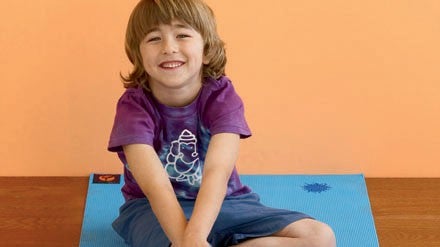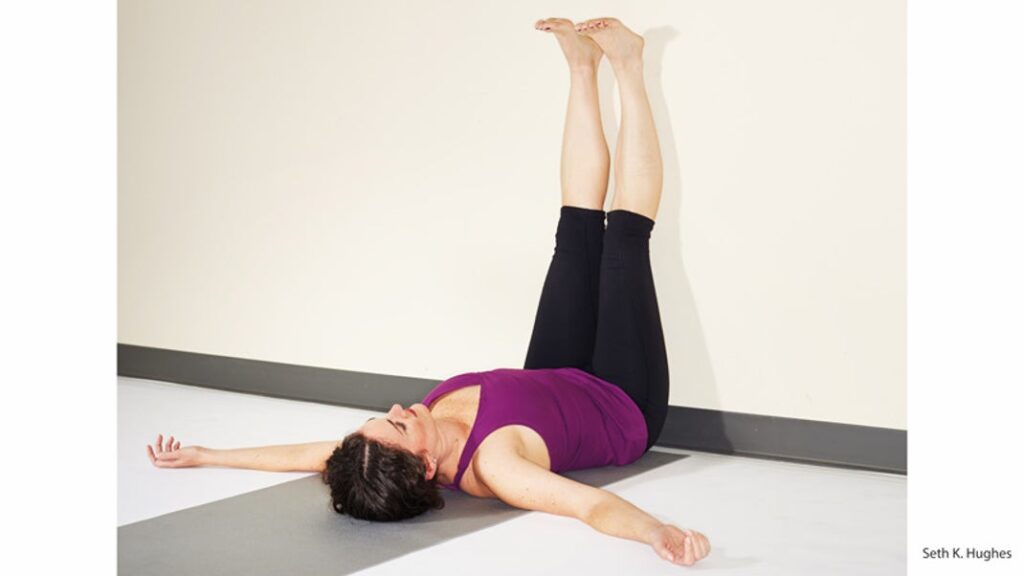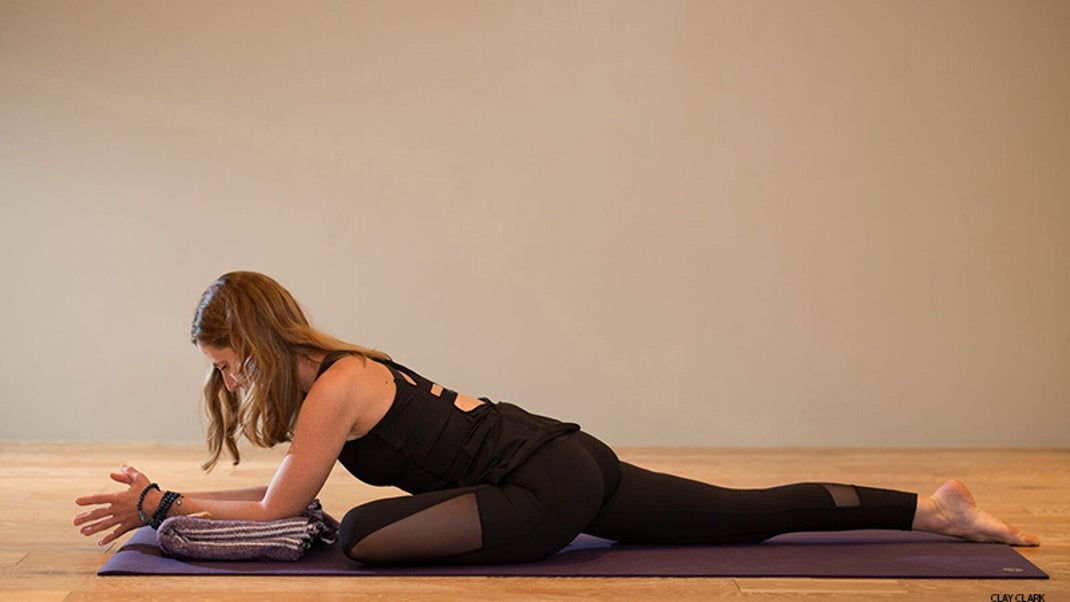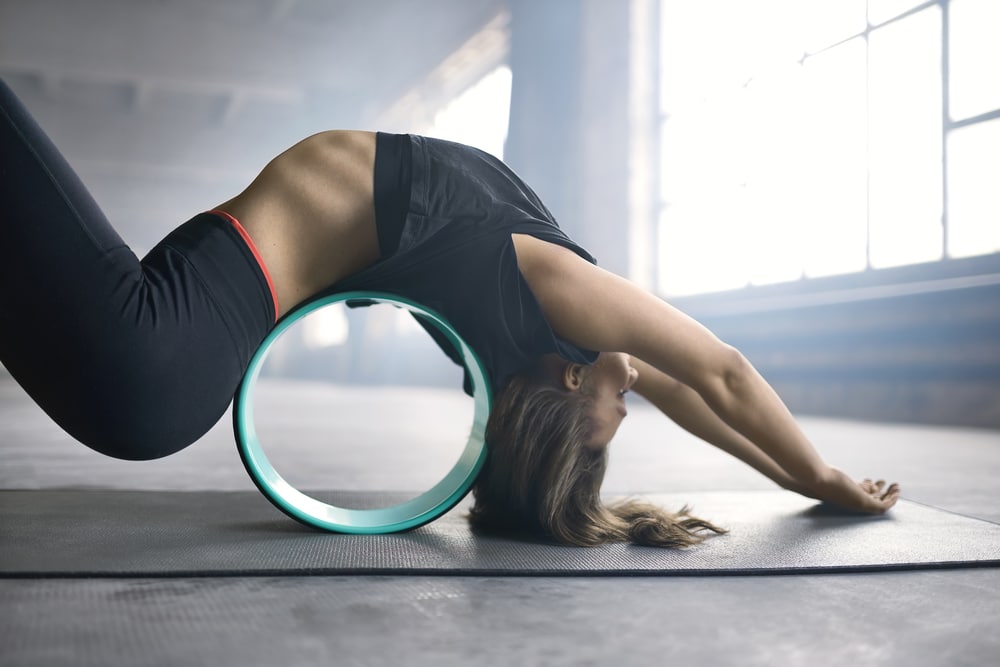It’s a typical Thursday morning at KIPP Summit Academy in San Lorenzo, California, as 20 seventh graders file into yoga class. There’s nothing loosey-goosey or crunchy-granola about the atmosphere. KIPP Summit (KIPP stands for “Knowledge Is Power Program”) is one of 125 KIPP public charter schools around the country whose mission is to help low-income and underserved kids go to college. The academic program is rigorous, and the expectations for good behavior are high. These expectations are palpable as the students, dressed in navy-blue polo shirts, leave their shoes at the door and take their place on pre-assigned mats, facing the blackboard. Yoga teacher Adam Moscowitz notices squirminess and chatter among the group and, bending forward with hands on knees, he says, “OK, I want it quiet in five.” As he counts down from five to one, the chatter disappears. With boundaries firmly in place, learning can begin.
Moscowitz has written six adjectives on the blackboard outlined in playful cartoon bubbles. The students have been immersed in standardized state tests this week, and Moscowitz takes a few minutes at the start of class to invite them to reflect on how they feel. “Are there any words on the board that reflect something you’ve experienced in this crazy week of testing?” The students respond with an enthusiastic but silent yes, shaking their hands back and forth, with palms facing each other, in front of their chests. (This silent signing is one of the quirks of KIPP Summit culture. It’s a way to keep the classroom contained. At KIPP Heartwood in San Jose, students are accustomed to being asked, “Is that clear?” and responding with a resounding “Crystal!”)
One by one, Moscowitz calls on the students to select a word from the board, and they share their feelings with surprising sincerity. Most of the kids simply feel relieved that the testing is over, but some are exhausted, nervous, stressed, or all of the above. Moscowitz encourages them to articulate why they feel the way they do, and he listens intently to each child. From there, the asana begins. As Moscowitz leads them through the series—including poses you’d see in any adult yoga class, such as Sun Salutations, Tree Pose, and seated twists—the students have varied reactions. Some seem to love it and go deep into quiet, others giggle throughout, and some look downright bored or checked out.
KIPP Summit eighth grader Andy Chen remembers being one of the bored ones when he started taking yoga at school three years ago. It took two full years of mandatory weekly classes before Chen took a liking to the practice. “I started realizing that yoga actually improved my athletic performance and calmed me down when I was in a bad mood. It got me focused, too,” says Chen, who plays basketball, football, and baseball. He counts Dolphin and Warrior as his favorite poses due to their strength-building qualities and the balance they bring him. He says that yoga helps him more than just physically; it also gives him an emotional outlet. “I remember this day when I came into yoga, like, really mad. I was raging, and unfocused at first. But Mr. Moscowitz said, ‘You just have to breathe. Don’t let everything around you distract you,’ ” says Chen. “That really helped me through the day. It made my day better.”
Head of the Class
Four years ago, KIPP Summit was one of the first schools in the KIPP network of schools across the United States to adopt a yoga program, and the administrators chose to partner with Headstand, a nonprofit organization based in San Francisco that brings yoga to economically challenged youth. Headstand now runs yoga programs at two other KIPP locations: KIPP Heartwood Academy in San Jose, California, and KIPP Academy Elementary in South Bronx, New York.
Headstand is one of many organizations bringing yoga to the thousands of public and private schools across the country that offer it to their students, either as part of the curriculum or as an after school activity. While the programs vary, the common thread is that teachers and school administrators are convinced that yoga is beneficial—perhaps even essential—to kids’ physical and mental health. At Brooklyn Latin School, a public high school that serves a racially and economically diverse group of students in New York City, weekly yoga classes help kids deal with the pressure of high academic expectations. At Tucson High School in Tucson, Arizona, yoga is offered as a health and physical education elective. And in Dover, New Hampshire, Yoga4Classrooms trains classroom teachers to incorporate short, calming practices into their lessons.
The mission of Headstand is a big one: “I want to normalize yoga and mindfulness inside K-12 schools,” says founder Katherine Priore. A former English teacher, Priore’s love of the practice led her to do several yoga teacher trainings, including one with Yoga Ed in Los Angeles, an organization that has trained some 900 teachers to teach yoga in schools since it was founded in 2002. After the Yoga Ed training, Priore decided to combine her passions for education, yoga, and social justice, and Headstand was the result.
“I want these practices, over time, to become equal to learning an academic area like science or math,” she says. And she wants to do it in schools where a majority of the students are living in low socioeconomic conditions (with at least 60 percent of students receiving federally funded meals), in neighborhoods where yoga studios don’t exist on every corner.
In order to make these things happen, Priore knew that yoga classes needed to be a required part of the curriculum—not an elective—because most kids, like Chen, discover yoga’s benefits only after repeated exposure. To encourage administrators to make yoga classes required, Priore created a standardized yoga curriculum that meets state standards for PE and health wherever it’s taught.
Yoga programs in schools are often taught by yoga teachers who don’t have a background in education, but Priore insists that classroom experience is vital and hires only yoga teachers who have at least three years’ experience as academic classroom teachers. Not only do classroom teachers know how to create lesson plans that are grade appropriate, but they know how to think on their feet when the plan bombs, they’re trained in getting buy-in from defiant students, and they understand the importance of making yoga fit into the school culture and support other academic areas. Teaching yoga to kids in the classroom, Priore says, requires a very different set of skills than teaching adults in a studio.
“You take the essence of yoga teachings, and then, Boom! Here’s a 10-year-old. How do you teach this idea to a 10-year-old? Then you also take the life skills and character traits that we know students need to develop, and you have to figure out, How do all of these things fit together?” She adds, “Engaging 20 little learners who aren’t paying 20 dollars for a class is tough!”
Moscowitz finds that in nearly every class he calls on the skills he developed as a high school English teacher. “Even though the benefits of yoga can be really perfect for these kids, I walk into this room knowing that they’re not necessarily convinced that they’re up for it on that particular day,” he says. One key to making his classes work is setting behavioral expectations, like using KIPP sign language instead of letting students shout out answers and requiring students to enter the yoga room quietly and to go to their assigned mats. These cues, says Moscowitz, help students understand that yoga is not recess or play time; they’re walking into a classroom where they’re expected to listen and learn.
The attention to detail that Priore and her staff put into the program has been noticed by both teachers and administrators. Andy Taylor-Fabe, an English teacher in his fifth year at KIPP Summit, says that he sees his sixth and seventh graders becoming better able to cope with and direct their unpredictable preteen energy in positive ways. “Kids have this false idea that you have to be crazy and super-energetic, or calm and sleepy, and those are the two ways to be,” he says. “In yoga they learn that they can be both calm and energetic. In terms of modifying behavior, that seems to be something that really helps them direct energy in ways that they haven’t been able to feel before.”
Strength of Character
As it is in most school yoga programs, stress reduction is an important part of what Headstand’s yoga classes offer to students, but it’s only one aspect of what Priore and KIPP staff think yoga can do. First and foremost, their goal is to provide the kids with tools to get to know themselves, to be self-reflective, and to ultimately become more compassionate, thoughtful, and happy people. In yoga, this concept of self-observation and self-reflection is often referred to as self-study. In the language of KIPP, it’s known as character building—and it’s an essential component of KIPP values because it is considered critical to the students’ long-term success.
Instilling strong character traits has always been part of the vision of KIPP’s co-founders, David Levin and Michael Feinberg, but their instinct to emphasize more than just academic study was confirmed by research that KIPP conducted in 2011. It showed that while KIPP kids do get into college, only 33 percent of the students who completed a KIPP middle school 10 or more years ago also graduated from a four-year college. (Although this is nearly 3 percentage points higher than the national average, KIPP’s goal is to see 75 percent of its students earn a bachelor’s degree or higher.) The key factor that determines whether a KIPP student graduates from college is not a successful academic history; it’s a combination of grades and character—that is, the ability to persevere, to remain optimistic, to advocate for him- or herself, and to cope with stress and frustration.
Priore believes that her yoga program can help students cultivate qualities that KIPP has deemed vital—qualities such as self-control, self-advocacy, grit, zest, optimism, and gratitude. “They can perform well on a test academically, but if they have the urge to punch someone when they get angry and they act on that urge, it’s going to be difficult,” she says. “The road is going to be a little rougher if they don’t understand impulse control—how to calm down and ultimately enjoy life. I think all kids should have access to these practices because they’re vital practices that are game-changing in education.”
Carolyn Petruzziello, the principal of KIPP Academy Elementary in the South Bronx, explains how building character is an essential part of a KIPP education, even in the younger grades: “Our school vision is that we really want our kids to love school and love learning, so we really work to develop the whole child. We say that we focus on academics 49 percent of the time and character 51 percent of the time,” she says. Her school uses the acronym SPROUT to convey its values: Serenity, Pride, Respect, Optimism, Understand, and Take a Risk. When she heard about the possibility of having a yoga program for kindergarten to third grade, she felt it would be a great fit. “We are really teaching our kids how to self-monitor and find serenity within themselves, even on a crazy day,” she says. “It just complements our program so well.”
To incorporate the character component into yoga, each Headstand class at KIPP includes homework or class work such as reading, writing, or journaling—that reflects the week’s teaching. A unit on responsibility might be accompanied by a writing assignment for which students must answer the question, “How can being aware of our feelings help us grow up responsibly?” The following week the students might address responsible ways to approach variations on a difficult pose. The overt teaching, discussions, and writing are supported by the asana portion of the class.
Learning Life Lessons
Eleventh grader Tracy Lord, who started taking yoga with Priore three years ago while she was at KIPP Summit, recalls how one particular teaching has helped her persevere in the face of academic stress. Lord waxes enthusiastic about her favorite poses—Tree and Half Moon— because “they help me get balanced,” and about Handstand because “it’s fun and challenging.” And she can tick off all the things she loves about the physical part of the classes: “I liked the peace. I liked the quietness. I liked the stability. I loved how the class was structured so you didn’t have to think too much. You could just literally go with the flow—like your body just flowed naturally.”
But the 16-year-old is equally enthusiastic as she talks comfortably about how yoga helped her to be less aggressively competitive, which used to leave her feeling stressed out and depleted. A self-professed perfectionist, Lord said that she found herself taking her competitive spirit into the yoga room and comparing herself to her classmates while they practiced. She remembers hearing Priore reminding the class one day that yoga is not about competing with others; it’s a practice you do for yourself, for your body and mind. That reminder has stuck with Lord as she prepares for college. “You always want to do your best because if you want to go to college, you have to always do your best. And, you know, there’s always people who are better than you, and that’s stressful. But I took what I learned from yoga, and I applied it to my academic life, and it made all the difference,” says Lord. “I feel like the stress is gone and now I can focus on myself and what I can do. I don’t have to stay up until 3 a.m. to try and beat some other person’s grades. I just do what I know I can do.”
Ultimately, Priore hopes to expand Headstand classes so that they’re offered in high school, too. If Lord and Chen (who will enter high school next year) had any say, there would already be such classes. Lord says she still pulls out her mat if she’s particularly stressed or if her back pain flares up, but her schedule is packed with advanced placement classes these days, and it’s hard for her to make the time. And although it took Chen two years to start appreciating yoga, he’s clearly one of the converted as he voices his disappointment about not having yoga classes after middle school: “I actually wanted to do yoga class in high school, and I got kinda sad when I heard it wasn’t offered anymore, but most folks don’t have it either, so…we’re just lucky, I guess.”
Taming Stress
It’s no secret that high school can be a pressure cooker, with ever-stiffer competition for college and the emotional turbulence that comes with being a teenager. At Monument Mountain Regional High School, a school serving over 500 students in Great Barrington, Massachusetts, yoga has become an antidote.
Four years ago, the school teamed up with yogis from the Kripalu Institute for Extraordinary Living as well as researchers from Brigham and Women’s Hospital and Harvard University to study how yoga might help high school students reduce stress. Initially, the researchers compared students assigned to take yoga class two to three times a week with students who took standard PE classes. The findings, published last spring in the Journal of Developmental & Behavioral Pediatrics, showed that over the course of the 10-week study, students in the yoga classes had fewer negative moods and less tension and anxiety than students in standard PE.
Now that the study is complete, the school has made yoga an elective—and students have continued to sign up. And kid’s are reporting that on the days they have yoga, they feel more capable of handling everyday stressors. “They are finding techniques they can use in any situation,” says school principal Marianne Young. “Yoga is here to stay. It’s become very mucha part of our school.”
Power to the Peaceful
Yoga practices and principles are ingrained in the culture of Chicago’s Namaste Charter School, a K-8 school whose 450 students are predominantly Hispanic and from low-income families. Namaste’s students start each day with 10 minutes of movement, including yoga and mindfulness techniques. It’s a way for the students to settle down and get ready to learn, says school spokesperson Mara Lidacis. As the practice winds down, she says, “The kids put their hands to their hearts and prepare to be attentive.”
Namaste’s PE teachers, as well as some of its classroom teachers, have been trained to teach yoga to kids, and yoga is part of the school’s PE offerings. This year, the school’s health and wellness programs earned a Gold Award of Distinction from the federal government’s Healthier U.S. School Challenge. But the school’s yoga focus goes beyond PE offerings. Each of Namaste’s classrooms has a peace corner where kids can go for some quiet time. “It’s about creating a stronger sense of self-awareness and awareness of others,” says Lidacis. “They can carry that with them every day.”
Self Centered
Getting a group of teenagers to lie down in Savasana or sit for meditation can feel like a near-miracle, say teachers at the James Baldwin School, a small, innovative public high school designed to help kids who’ve struggled academically in other schools. It can also make a big difference in their behavior. “When kids learn to really practice quiet, they’re more in control. They think before they act. There’s an emotional-social transformation,” says Rehana Ali, the school’s social worker and co-founder of its for-credit yoga class. The class is led by teachers from the Integral Yoga Institute and held at its nearby Greenwich Village studio. Students learn asana, meditation, and nutrition and even go on a three-day retreat at a yoga center in upstate New York. Ali says yoga gives the students—many of whom have experienced trauma such as violence at home—the skills to quiet their minds, calm their emotions, and care for their own mental and physical health.
Conclusions:
Students raised with violence in the home or neighborhood bring that with them to school, Ali says, but the kids who take yoga will often encourage each other to stop and breathe instead of fighting. “We wanted to give them a new language, a new paradigm,” Ali says. “Yoga helps them cultivate a better relationship with themselves and other people.”






